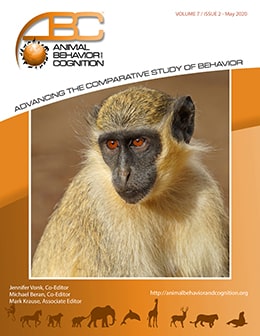Vol 7, Issue 2, May 2020
Can Nonhuman Primate Signals be Arbitrarily Meaningful like Human Words? An Affective Approach
Citation
Sievers, C., & Gruber, T. (2020). Can nonhuman primate signals be arbitrarily meaningful like human words? An affective approach. Animal Behavior and Cognition, 7(2), 140-150. doi: https://
doi.org/10.26451/abc.07.02.08.2020
Abstract
Whether one can label nonhuman primate signals as ‘meaningful’ hinges on what one takes as central features to meaning. If one targets a notion of meaning closely related and comparable to meaning in human words, two features must be identified: firstly, a concrete ascribable meaning to the signal and, secondly, an element of convention or arbitrariness of the signal’s meaning. In their seminal paper published in 1980, Seyfarth, Cheney and Marler demonstrated that vervet monkey alarm calls have concrete, discrete, ascribable meaning. But what about their arbitrariness? Here we will suggest a potential way into the investigation of this second feature: Human individuals are capable of comprehending arbitrary word meaning through learning and teaching processes. The current theory suggests in particular that imitation learning and natural pedagogy-like teaching behavior are necessary. For nonhuman primate signals, there is high doubt that learning processes are involved in the acquisition of novel signals, for instance, during ontogeny, and even higher doubt in the involvement of natural pedagogy. We will tackle the question of why complex imitation learning and natural pedagogy is not necessary for animal signals to be arbitrarily meaningful. We will also argue that the framework of ASL – Affective Social Learning – can help us determine whether simple forms of learning and passive forms of (indirect) teaching hinging on affective states of the teacher are involved, allowing for an arbitrary character of nonhuman signals.
Keywords
Nonhuman primate communication, Meaning, Social learning, Teaching, Arbitrariness
